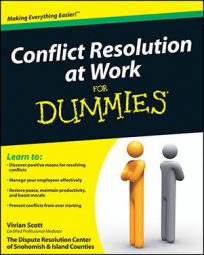Mediating a workplace conflict that ends in successful resolution can be hard work — and the work doesn't stop there. Follow up by watching for positive changes in employee relationships to ensure long-term success. Any behavior that indicates employees are more open, positive, and understanding with each other helps the team function better.
Watch for changes that help you gauge how current behaviors match pre-mediation interactions. You may see changes with specific individuals or within the group as a whole. Behaviors like the following indicate progress:
Open and relaxed interactions between staff members: Smiling and cordial behavior goes a long way toward rebuilding relationships. Something as simple as saying “good morning” fosters contentment and goodwill among staff.
Try jump-starting a more relaxed atmosphere by modeling the behavior you’d like to see the previously conflicted employees display.
The reduction of cliques and isolated groups: If the facilitation that took place was with a larger group, look to see if the members of the team are interacting more freely. If you’re on the right track, you should notice a decrease in separation and isolation along with outward efforts to include others where they were previously excluded.
More cooperation: Look for an increased willingness from co-workers to interact and collaborate. A new or renewed interest in taking on projects that require teamwork is a huge step (as opposed to an employee saying he’ll just do it all himself).
More positive attitudes toward each other: After a difficult situation is resolved, your employees may be more likely to give each other the benefit of the doubt instead of jumping to conclusions and being quick to take offense at a poorly worded or ill-timed comment.
When possible, encourage interactions and give co-workers a chance to improve working relationships by
Assigning projects to a different mix of employees: Depending on how specialized an employee’s skills are and the nature of the task at hand, create tasks that can build on renewed relationships.
Creating a task force or committee that makes sense for the business but allows for relationship building: One company created a committee comprised of one representative from each department to plan a monthly luncheon. The cost of the lunch was a minimal investment in building positive cross-departmental relationships.
Looking for opportunities to get your staff out of the workplace and focused on a different project: Some organizations have volunteer opportunities or community enhancement projects that provide opportunities for co-workers who may not get to interact on a daily basis to pair up and get to know each other a little better.
Don’t push employees together if they aren’t ready. If tensions are still high, you could do more harm than good by forcing folks to work together on a joint project. Timing is everything; so wait for things to calm down before deciding to pair up previously combative staff.

